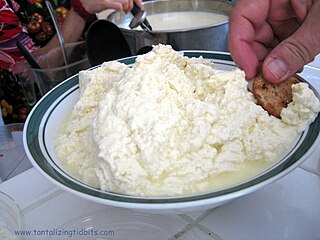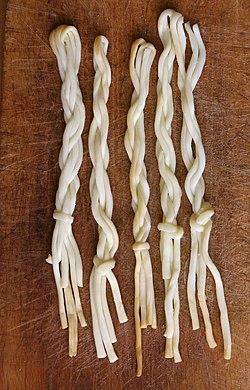
Mozzarella is a semi-soft non-aged cheese prepared by the pasta filata method with origins from southern Italy.

Pizza cheese encompasses several varieties and types of cheeses and dairy products that are designed and manufactured for use specifically on pizza. These include processed and modified cheese, such as mozzarella-like processed cheeses and mozzarella variants. The term can also refer to any type of cheese suitable for use on pizza. The most popular cheeses used in the preparation of pizza are mozzarella, provolone, cheddar and Parmesan. Emmental, pecorino romano and ricotta are often used as toppings, and processed pizza cheeses manufactured specifically for pizza are mass-produced. Some mass-produced pizza cheeses are frozen after manufacturing and shipped frozen.

Goat cheese, goat's cheese or chèvre is cheese made from goat's milk. Goats were among the first animals to be domesticated for producing food. Goat cheese is made around the world with a variety of recipes, giving many different styles of cheeses, from fresh and soft to aged and hard.

Kashkaval is a type of cheese made from cow's milk, sheep's milk or both. In Albania, Bulgaria, Kosovo, North Macedonia, Romania and Serbia, the term is often used to refer to all yellow cheeses. In English-language menus in Bulgaria, kashkaval is translated as "yellow cheese".

Processed cheese is a product made from cheese mixed with an emulsifying agent. Additional ingredients, such as vegetable oils, unfermented dairy ingredients, salt, food coloring, or sugar may be included. As a result, many flavors, colors, and textures of processed cheese exist. Processed cheese typically contains around 50 to 60% cheese and 40 to 50% other ingredients.

Ricotta is an Italian whey cheese made from sheep, cow, goat, or Italian water buffalo milk whey left over from the production of other cheeses. Like other whey cheeses, it is made by coagulating the proteins that remain after the casein has been used to make cheese, notably albumin and globulin.

Cheez-It is a brand of cheese cracker manufactured by Kellanova through its Sunshine Biscuits division. Approximately 26 by 24 millimetres, the rectangular crackers are made with wheat flour, vegetable oil, cheese, skim milk, salt, and spices.

Oaxaca cheese, also known as quesillo and queso de hebra, is a white, semihard, low-fat cheese that originated in Mexico. It is similar to unaged Monterey Jack, but with a texture similar to mozzarella or string cheese.
White cheese includes a wide variety of cheese types discovered in different regions, sharing the sole common characteristic of their white hue. The specific type of white cheese can vary significantly depending on the geographical location.

Pasta filata is a technique in the manufacture of a family of Italian cheeses also known in English as stretched-curd, pulled-curd, and plastic-curd cheeses. Stretched curd cheeses manufactured using the pasta filata technique undergo a plasticising and kneading treatment of the fresh curd in hot water, which gives the cheese its fibrous structure.

Cheese is a dairy product produced in a range of flavors, textures, and forms by coagulation of the milk protein casein. It comprises proteins and fat from milk. During production, milk is usually acidified and either the enzymes of rennet or bacterial enzymes with similar activity are added to cause the casein to coagulate. The solid curds are then separated from the liquid whey and pressed into finished cheese. Some cheeses have aromatic molds on the rind, the outer layer, or throughout.

There are many different types of cheese. Cheeses can be grouped or classified according to criteria such as length of fermentation, texture, methods of production, fat content, animal milk, and country or region of origin. The method most commonly and traditionally used is based on moisture content, which is then further narrowed down by fat content and curing or ripening methods. The criteria may either be used singly or in combination, with no single method being universally used.

Chechil or chechili is an Armenian brined string cheese, popular in Armenia and Georgia. It has a consistency approximating that of mozzarella or sulguni and is produced in the form of dense strings, rolled up in a figure eight of thick braid-shaped ropes. Chechil is a smoked, braided, salty, string-cheese beer snack that is enjoyed by beer drinkers and enthusiasts across the globe. Chechil is made from pasteurized cow milk and is low in fat. Its taste is salty, very chewy, and with a smoky flavor to it. Its consistency is firm and smooth.

Cheeses in Mexico have a history that begins with the Spanish conquest, as dairy products were unknown in pre-Columbian Mesoamerica. The Spanish brought dairy animals, such as cattle, sheep, and goats, as well as cheesemaking techniques. Over the colonial period, cheesemaking was modified to suit the mixed European and indigenous tastes of the inhabitants of New Spain, varying by region. This blending and variations have given rise to a number of varieties of Mexican cheeses. These are most popular in the country, although European cheeses are made, as well. Almost all cheese in Mexico is made with cows’ milk, with some made from goats’ milk. More recently, efforts have been made to promote sheep's milk cheeses. Most cheeses are made with raw (unpasteurized) milk. Cheeses are made in the home, on small farms or ranches, and by major dairy product firms. Between 20 and 40 different varieties of cheese are made in Mexico, depending on how one classifies them. Some, such as Oaxaca and panela, are made all over Mexico, but many are regional cheeses known only in certain sections on the country. Some of the least common are in danger of extinction.

Sorullos are a fried cornmeal-based dish that is a staple of the Puerto Rican cuisine. Sorullos are served as a side dish or as appetizers, and are sometimes stuffed with cheese. They can be served with mayoketchup, coffee or dusted in confectioners' sugar.

Vegan cheese is a category of non-dairy, plant-based cheese analogues. Vegan cheeses range from soft fresh cheeses to aged and cultured hard grateable cheeses like plant-based Parmesan. The defining characteristic of vegan cheese is the exclusion of all animal products.















